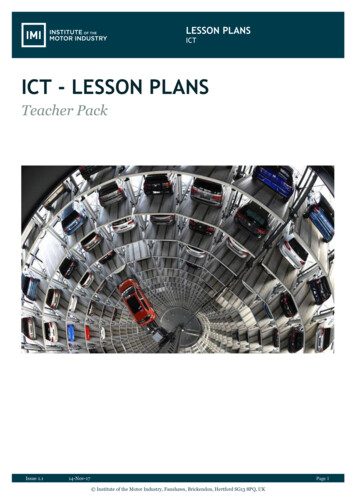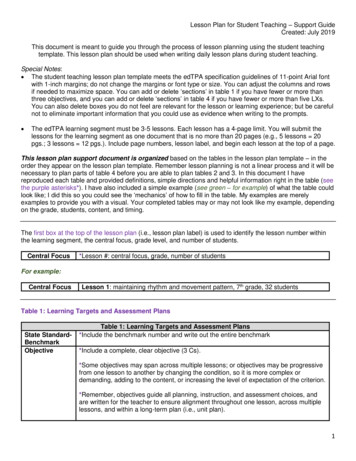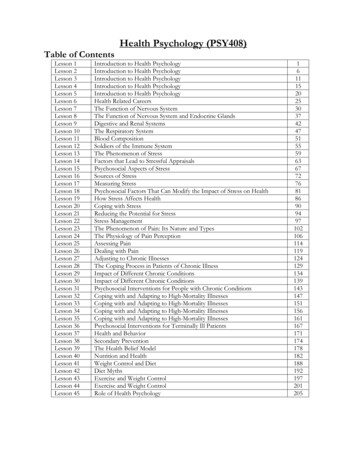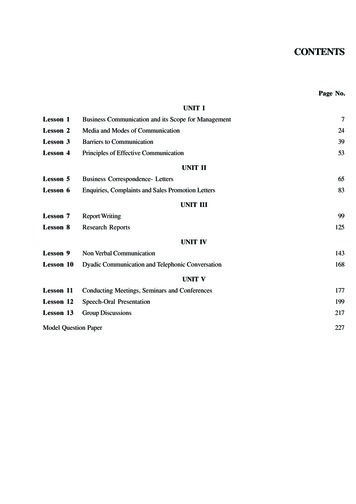
Transcription
Introduction to Business Administration Lesson 66. The Company and the Administrative ProcessEvery successful company has an identity and a establishing a clear andmemorable identity is the first step in rebuilding, improving, or starting a company.6.1 Administrative Process of PlanningEvery business must have a planDocument generally projects 3-5 years ahead and outlines the route a companyintends to take to grow revenues.Vital for request businessing loans from banksYour business plan should have an: Executive Summary - The Executive Summary is the most important part ofyour business plan. Because if it doesn’t interest readers, they’ll never evenget to the rest of your plan. Company Description - provides a brief history of your company. Market Analysis - Market Overview/ Relevant Market Size Customer Analysis - Target Customers/Customer Needs Competitive Analysis - Direct Competitors/Indirect Competitors/Competitive Advantage Marketing Plan - Products & Services/Pricing/Promotions Plan/Distribution Plan Operations Plan - Key Operational Processes/Milestones Management Team - Management Team Members/Management TeamGaps/Board Members Financial Plan - Revenue Model/Financial Highlights/FundingRequirements/Use of Funds/Exit Strategy Appendix - Supporting Documentation ((income statement, balance sheetcash flow statement, customer lists, awards, and patents received amongothers)1
6.2 The OrganizationAn organization is a - social unit of people that is structured and managed to meeta need or to pursue collective goals.All organizations have a management structure that determines relationshipsbetween the different activities and the members, and subdivides and assigns roles,responsibilities, and authority to carry out different tasks.6.3 The ExecutivesBoard Of Directors - A group of individuals that are elected as, or elected to act as,representatives of the stockholders.Establish corporate management related policies and to make decisions on majorcompany issues: Hiring/firing of executives,Dividend policiesOptions policiesExecutive compensationEvery public company must have a board of directors.fair representation of both management and shareholders6.4 The IntegrationTwo types of Integration Horizontal VerticalHorizontal Integration is the acquisition of additional business activities that are atthe same level of the value chain in similar or different industries.This can be achieved by internal or external expansion.2
Because the different firms are involved in the same stage of production, horizontalintegration allows them to share resources at that level. If the products offered bythe companies are the same or similar, it is a merger of competitors.Sometimes referred to as lateral integration.Vertical Integration is when a company expands its business into areas that are atdifferent points on the same production path.For example, when a manufacturer owns its supplier and/or distributor.Vertical integration can sometimes help companies reduce costs and improveefficiency by decreasing transportation expenses and reducing turnaround time,among other advantages.6.5 The ControlControlling – Meeting objectives and measuring and learning from them.Controlling comparing actual to planned performance and taking necessarycorrective action.6.5.1 Management Control FunctionsControl Process1.2.3.4.5.Set Standards by which performance will be measuredMeasuring performanceCompare actual performance with standards and identify any deviationsDetermine the reason for the deviationsTake corrective actions if needed6.5.2 The Business StrategyStrategy stars with planning Core organizational valueso Fundamental belief of what is most important in conductingactivities should be established and defines by managers alongwith the key stakeholders.3
Objectives should be definedo The ends or results desired by the organization and derived fromthe organization’s mission Mission should be defined (two sentences max or 140 characters)o Statement of an organization’s fundamental purpose and basicphilosophy.6.5.3 The Successful BusinessmanThe successful businessman has all of aspects of an entrepreneur.The successful businessman has: VisionPlansPassion for enterpriseAnalytic skills – good working with numbers and budgetsCommunication Skills6.5.4 Characteristics of a successful company1.Audience KnowledgeThe best brands have a thorough understanding of the demographics of theirtarget market, what their interests are, and how they communicate.Understanding the target market is critical because it provides direction for thetone and reach of a marketing campaign, along with the overall identity of abrand.2.UniquenessEstablishing a brand identity requires something distinctive.Apple is known worldwide for their innovative products and minimalistic,aesthetic appeal.4
Domino’s Pizza used to guarantee that their pizza would arrive in 30 minutes orit’d be free.In terms of a selling point, TOM’s shoes donate a free pair of shoes to a child inneed for every pair of shoes that are bought.3.PassionWhile it’s certainly possible to build a brand in the short-term without passion,it’s almost impossible to sustain it in the long run.Serious passion keeps propelling work hard and continually deliveringgreatness. That passion leads to enthusiasm and genuine joy, which isinfectious.Consumers often become just as enthusiastic about a product or service, leadingto word of mouth advertising and referrals and preserving a business.4.ConsistencyWhen consumers come back to a business for repeat sales, they usually expectto receive the same level of quality as they did the first time. Restaurants andtheir food and service quality are a great example of this.5.CompetitivenessFor a brand to make a name for itself, team members should thrive oncompetition and constantly strive to improve.Work tirelessly toward building and optimizing their brandGoing above and beyond consumer expectations. The end result tends to be abrand that is continually on the cutting edge of its industry.5
Every business must have a plan Document generally projects 3-5 years ahead and outlines the route a company intends to take to grow revenues. Vital for request businessing loans from banks Your business plan should have an: Executive Summary - The Executive Summary is the most important part of your business plan.











